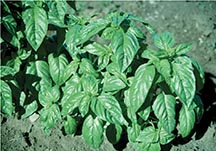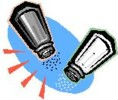Make the most of culinary herbs and spices.
Other articles you might enjoy:
2. Look What I Made: An Herb Drying Rack
3. Basil Questions and Answers Page
4. The Pleasure of Fresh Herbs
5. The Great Garlic Roasting Experiment
A Bounty of Basil: How to Preserve the Harvest
by Sandra Bowens
Here's one that's full of our favorite recipes because we wrote the book! It is also full of information, helpful hints and ideas for using herbs and spices in your kitchen.

photo courtesy of National Garden Bureau
Blanching defined: "To plunge food (usually vegetables and fruits) into boiling water briefly, then into cold water to stop the cooking process. Blanching is used to firm the flesh, to loosen skins (as with peaches and tomatoes) and to heighten and set color and flavor (as with vegetables before freezing)." The Food Lover's Companion by Sharon Tyler Herbst
One of the most common questions to this site is "can you freeze basil?" The short answer is yes. The more elaborate answer involves how best to do it. As regular readers know, I love to experiment so I decided to play with the idea.
Since it was mid-winter when I became inspired I had to turn to the supermarket for the basil. I stumbled upon a magnificent find. Fresh basil, roots still attached. Living basil, the package said. I brought it home, popped the root cubes into a glass of water and devised my plan.
First, the freezer
Most of the books on my shelf suggest blanching basil leaves before freezing. This involves dipping the basil first into boiling water for 15 seconds and then into ice water before drying on paper towels. The leaves then must be laid out flat for the freezer. Once frozen, you can transfer the basil to a container. Although it worked, I found this process tedious, time-consuming and it required too much space in the freezer initially. The preserved basil was tasty but no substitute for fresh.
Just to see what would happen, I arranged a few nice big leaves on a plate and stuck them in the freezer. The basil emerged from the freezer with no change in shape or color but they thawed quickly, shrunk and became difficult to work with.
Cubes
My favorite way to preserve fresh basil has long been to chop it and then freeze into ice cubes. To thaw, you simply drop a few in a strainer and let the ice melt away or even just drop them frozen into a sauce or soups. Wondering if I could improve on this in any way, I tried several ideas.
For a side by side comparison, I measured two teaspoons chopped basil into each of the cube molds. To half, I added water, as usual, the others I filled with extra-virgin olive oil. After freezing, the cubes with oil had become cloudy and broke as I tried to unmold them. The basil was the same in both cases; good for cooking with but not for using fresh or as a garnish.
The food processor came out for the next trial. I packed leaves with some tender stems into a half-cup measure and whirled them with a quarter cup of extra-virgin olive oil. This created a nice paste that froze well and popped right out of the ice cube trays. When thawed the basil oil was excellent for whipping into a salad dressing or adding to cooked recipes.
Submerged in oil
Another preservation method I have used in the past is basil oil. This is good for the short term but not really recommended since the risk of botulism is high. Occasionally mold will form as well so you end up wasting a lot of good basil and expensive olive oil. But you might like to try it with the idea of using the flavored oil within a week or two while keeping it refrigerated. To hold it any longer go for the freezer (not the refrigerator--botulism is still possible there).
The method is simple and I had good results during my recent experiments. Place 1/2 cup of olive oil in a small skillet over medium heat. Warm it just until you can hold your hand over the oil and feel heat. Add a 1/2 cup of torn basil leaves and remove from the heat. Allow it to return to room temperature and transfer to a squeaky clean glass jar. Store in the refrigerator for only a week or freeze it.
Flavored oils can be used in a variety of creative ways. Salad dressings, a drizzle to garnish, sautéing vegetables, cooking eggs, the possibilities are endless.
The basil stems were piling up next to the cutting board as I worked through all these combinations. I couldn't resist seeing what would happen if I tried to make an oil with just stems. I went through the same process of heating the oil (a half cup) and adding a quarter cup of the snipped stems. A couple of days later, the surprising result was an oil with an intense herby flavor that tasted nothing like basil.
Packed in salt
As I combed through cookbooks and the Internet for other ideas about preserving basil, one in particular fascinated me. The Herb Society's website suggested layering basil leaves in sea salt. I couldn't resist.
Starting in a 14-ounce plastic container with a tight fitting lid, I poured a layer of kosher salt to cover the bottom. I added a single layer of basil leaves-not overlapping-covered them with salt and continued the process until the container was full. Even months later the refrigerated leaves emerged well-preserved. They had a sort of papery texture but were hands down the closest I had come to keeping the integrity of the fresh basil. The salt doesn't take on any notable basil flavor so I have recycled it back into everyday use.
Don't forget pesto
Pesto is one of the handiest ways to extend the basil harvest. Since you don't need much to flavor a dish, freezing it into ice cubes or tiny containers makes perfect sense. You can keep fresh pesto in the refrigerator for a week or two. A thin layer of oil on top will keep it from discoloring. See Endless Pesto Possibilities for more on this savory subject.
Drying has a place, too
Although I didn't include drying basil in this round of testing, it is always an option. Basil will lose some of its flavor but your own freshly dried herbs are bound to be better than anything you can buy.
Harvest the leaves and arrange them on a screen, to provide air circulation, or bunch them together and hang your bouquet upside down in a dry, airy place. Make sure the basil is completely dry (otherwise the leaves will mold) before crumbling into a spice jar.
Storage tips
The new trend in containers, those "reusable disposable" snap-top numbers, have become indispensable in my kitchen. The small two-ounce (1/4 cup) sized containers came in handy during all of these experiments. They perform well in the freezer, don't leak and you know exactly how much they hold.
If you choose to freeze your basil or pesto in ice cube trays, after they are frozen you can transfer the cubes into a freezer-grade storage bag. If you freeze individual blanched leaves, you can also collect them into a storage bag once they have frozen.
The bottom line
One thing became clear after trying all these methods for preserving basil. None really kept the leaves with a texture to use as a fresh garnish. However, they all worked for adding that wonderful taste to foods that you get when using fresh basil rather than dried. I think I will continue to depend on my reliable method of freezing chopped basil with water in the ice cubes trays. I can always add the oil later.
Other notes
For more information about "living basil" see the Utsalady Farm website.
More great recipes for using your preserved basil: Meatball Minestrone, Grainy Mustard with Sun-dried Tomatoes and Basil, Basil Pesto and other pesto recipes.
To see the Internet entry about preserving basil in salt, visit the Herb Society's website.
Recipes
Mozzarella, Tomato and Basil Plate
Before preserving any of your basil, be sure to put the fresh leaves to work in making this delicious appetizer.
1 ball (8 ounces) fresh mozzarella
1 large ripe tomato
1/2 cup fresh whole basil leaves
2 Tablespoons extra-virgin olive oil
Kosher salt
Freshly ground black pepper
Use a serrated knife to halve the ball of mozzarella and then slice into 1/4-inch thick half moons. Slice the top and bottom off of the tomato; chop these pieces into a fine dice and set aside. Slice the tomato in half down through the center and then cut each half into 1/4-inch thick half moons.
Working in a circle on a dinner plate-sized serving platter, overlap the slices of mozzarella and tomatoes. Tuck a basil leaf in between each layer, allowing much of the leaf to show. Arrange the reserved diced tomatoes in the center of the plate and garnish with another basil leaf or two. Drizzle the olive oil over everything; sprinkle with the salt and pepper.
Serve with a nice crusty bread, preferably homemade.
Makes two or three servings.
Basil Vinaigrette
For a light meal, try serving this vinaigrette over a piece of grilled or broiled fish atop a green salad. Consider it, too, as a sauce for steamed vegetables or boiled potatoes.
1 or 2 basil/oil cubes (depending on size), thawed in a 1/4 cup measure
(to use fresh basil, place 2 Tablespoons minced basil into a 1/4 cup measure and fill with oil)
olive oil, as needed
2 teaspoons white wine vinegar
1 teaspoon lemon juice
1/2 teaspoon Dijon-style mustard
1 small garlic clove, minced
1 teaspoon snipped fresh chives
dashes of salt, to taste
freshly ground black pepper, to taste
If necessary, add enough olive oil to the thawed basil cubes to fill the 1/4 cup measure.
Combine all these ingredients in a small container with a lid and shake very well. Taste for seasonings; adjust as necessary.
Makes 1/3 cup

Our go-to guide for dealing with things that wiggle and squirm or make our plants sick.
Use flowering herbs to punch up landscape design. This guide covers 700 plants from 80 families.
Solve your problems, settle your curiosity or just entertain yourself with this collection of over 6000 kitchen wisdom nuggets.
Learn herb gardening from the ground up, literally, with the help of a knowledgeable teacher and gardener.
Herbal vinegars are some of the most versatile elixirs you can keep on hand or give as a gift. Here you will find inspiration, ideas and recipes for other delicious concoctions.







